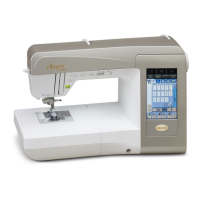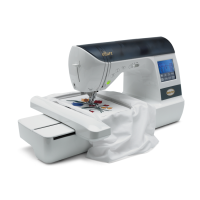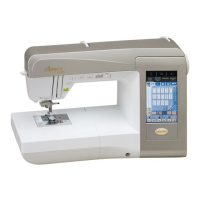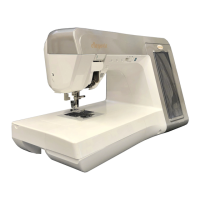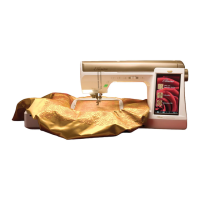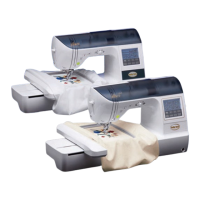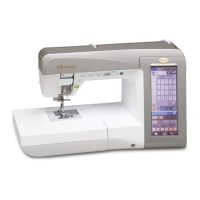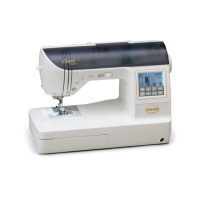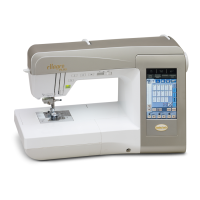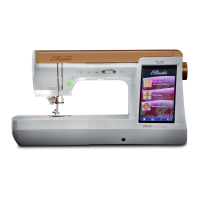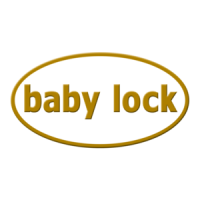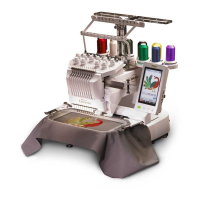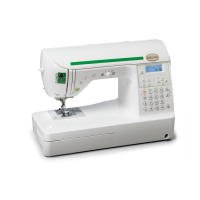
Do you have a question about the Baby Lock Elizabeth BL200A and is the answer not in the manual?
| Stitch Width | 7mm |
|---|---|
| Stitch Length | 5mm |
| Needle Position | Variable |
| Speed Control | Yes |
| Start/Stop Button | Yes |
| Needle Up/Down | Yes |
| Feed System | Drop Feed |
| Maximum Stitch Width | 7mm |
| Maximum Stitch Length | 5mm |
| LCD Screen | Yes |
| Free Arm | Yes |
| Bobbin Type | Drop-in |
| Needle Threader | Yes |
| Buttonholes | 1-step |
| Stitches | Decorative |
| Presser Feet | 7 |
| Type | Electronic |
Key safety guidelines for operating the sewing machine.
Recommendations to ensure the machine's longevity and proper care.
Steps to follow in case of machine malfunction or required adjustments.
Critical safety warnings regarding electrical shock, burns, fire, and injury.
Overview of key features and functionalities of the sewing machine.
List of items that should be included in the sewing machine package.
List of additional accessories available for purchase to enhance machine functionality.
Identification and description of parts visible from the front of the sewing machine.
Details of the needle and presser foot area and their components.
Identification and description of parts visible from the right and rear sides of the machine.
Explanation of the purpose and operation of various control buttons on the machine.
Description of the LCD screen and keys for setting sewing parameters.
Essential safety measures for connecting and disconnecting the sewing machine's power.
Explanation of what is shown on the LCD screen, including settings and error messages.
Procedure for modifying machine attributes like stitch settings and screen options.
Important warnings and guidelines for handling and using the bobbin.
Step-by-step guide for properly threading the upper thread path.
Instructions for threading the needle manually and with a twin needle.
Safety guidelines and information on selecting the correct needle for different fabrics.
Safety warnings and guidelines for attaching and using presser feet.
How to adjust the pressure applied by the presser foot to the fabric.
Instructions for installing and uninstalling the walking foot accessory.
Methods for sewing cylindrical items and large fabric pieces using the free arm.
Fundamental procedures and precautions for basic sewing operations.
Guide on correctly aligning and placing fabric under the presser foot for sewing.
Step-by-step instructions for performing basic sewing operations.
How to begin sewing using either the operation buttons or the foot controller.
How to adjust the upper thread tension for balanced stitching.
Procedure for widening or narrowing the stitch width for different stitches.
How to modify the stitch length to make stitches longer or shorter.
Setting the needle to stop up or down in the fabric after sewing.
Enabling automatic reinforcement stitches at the start and end of sewing.
Setting the machine to automatically cut threads upon completion of sewing.
Storing custom stitch width and length settings for later use.
Importance of testing stitches on scrap fabric before sewing the project.
Tips for sewing thick, thin, and stretch fabrics for best results.
Methods for achieving an even seam allowance using fabric guides.
Guide on choosing and setting up various stitch types and patterns.
How to sew overcasting stitches to prevent fabric fraying.
Instructions for performing basic stitches like basting and straight stitching.
How to sew blind hems on skirts and pants for a neat finish.
Procedures for sewing buttonholes and attaching buttons to fabric.
Methods for sewing zippers into garments, including centered and side zippers.
Techniques for sewing stretch fabrics and attaching elastic tape.
Stitches for decorative appliqué, patchwork, and quilting projects.
Techniques for patchwork sewing, including crazy quilt patterns.
Method for sewing two fabric pieces together for quilting or garments.
Instructions for sandwiching batting and fabric layers for quilting.
Techniques for moving fabric freely for decorative quilting stitches.
Using triple stretch stitches to reinforce seams and stress points.
Sewing bar tacks to reinforce pocket corners and openings for durability.
How to use the darning stitch to repair torn fabric.
Instructions for creating eyelets of different sizes on fabric.
Sewing decorative bridging stitches for open seams, often on blouses.
Creating shell-like gathers for decorating trims and edges of garments.
Sewing wave-shaped patterns for decorative edges on collars and handkerchiefs.
Creating decorative stitches over gathers for texture and elasticity.
Considerations for correctly sewing decorative patterns, including fabric and needle choice.
How to sequence and sew multiple decorative patterns together.
Setting the machine to repeatedly sew a selected pattern or sequence.
Verifying the sequence of combined patterns displayed on the LCD.
Reference table for stitch applications, widths, lengths, and compatibility.
Details on stitch applications, widths, lengths, and compatibility for utility stitches.
Overview of decorative, satin, cross, and other stitch types and their properties.
Instructions for cleaning the exterior surfaces of the sewing machine.
Procedure for cleaning the bobbin case area to ensure optimal sewing performance.
Solutions for common issues when the sewing machine does not start or run.
Causes and remedies for the upper thread breaking during sewing.
Troubleshooting steps for issues with the bobbin thread tangling or breaking.
How to correct incorrect thread tension issues affecting stitch quality.
Solutions for fabric wrinkling or puckering during the sewing process.
Troubleshooting steps for skipped stitches due to needle or threading issues.
Identifying and resolving causes of unusual noises during sewing machine operation.
Steps to take if the LCD screen remains blank when the machine is turned on.
